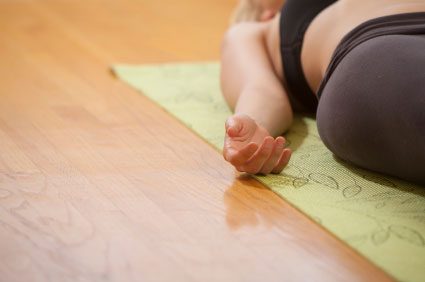4 core exercises that don’t involve plank
Doing endless planks isn’t the only route to a stronger core. Increase strength and stability with these plank-free moves

Want to stand taller and be stronger at everything you do? It all starts with the core’the deep trunk muscles that stabilize the whole body. "The core is comparable to the foundation of a house," says Leslie Hopkins, a certified yoga and Pilates instructor based in Toronto. "If you don’t have a solid foundation, then everything else can crumble if you’re not careful."
What is the core, anyway, and why does it matter?
The core isn’t just your abs’though that’s a common misconception. The four layers of abdominal muscle do form part of the core, but the term also includes small stabilizing muscles in the spine and pelvic girdle, all the muscles together providing "three-dimensional support and stabilization through the spine and pelvis," says Hopkins.
A stronger core means a stronger spine and pelvis’and that strength benefits the entire body, notes Hopkins, whether you’re an athlete performing in high-impact sports or, like many of us, simply sitting at a desk all day. Unfortunately, "lots of us don’t engage the core as often as necessary," says Hopkins. Instead, "we tend to make movements from the larger and more superficial muscle groups."
Practising core work will help you reconnect with the neural pathways that allow you to properly use the core, she adds’and that means not just doing core exercises in your workout, but also engaging the core in everyday activities such as standing and sitting, riding the bus, and lifting or pushing objects.
How to get a stronger core (no planks required)
"You do not have to do plank," Hopkins says’though she adds that it is a great way to feel core engagement, and that if you do hate it, you should start small (knees on the ground), with forearms on the ground if your wrists hurt, and build slowly. "We often surprise ourselves," she says.
Plank aside, here are four exercises Hopkins shared with us for you to try at home, starting with a basic breathing exercise to help you connect with the core muscles. As always, check with your doctor or another healthcare professional before making any major changes to your fitness regime, or if you have any injuries or health conditions. All exercises can be done on a yoga, Pilates or exercise mat or on a carpeted floor.
1. Pelvic tilts
"This exercise is a warm-up for the core," Hopkins says. "It shouldn’t feel exhausting and is a very small, controlled movement to help you isolate the proper muscles."
‘ Lie flat on your back with your knees bent and feet on the floor hip distance apart, arms straight and down by your sides.
‘ On an exhale, slowly pull the belly button down toward the front of your spine and lift the pelvic floor muscles (Kegels) as you gently tip the pelvis and bring the lower back into the mat. (Imagine a marble on your pubic bone rolling toward your navel.) All the work should be coming from your core muscles, not from your legs or arms.
‘ On an inhale, slowly and with control bring the pelvis back to the starting position.
‘ Repeat 10 times.
2. TA (transversus abdominus) trampolines
"This exercise really targets the deepest core muscle, the transversus abdominus, and the small spinal stabilizers," says Hopkins.
‘ Get on your hands and knees with knees directly underneath the pelvis and hands directly underneath the shoulders.
‘ Keep your head in line with the rest of the body, and be careful not to start with a large curve in the small of your back. The spine should stay stable throughout this exercise’don’t sink into your back.’
‘ Inhale to prepare.
‘ On an exhale, slowly draw the belly button up toward the spine, lifting the stomach up and away from the floor while maintaining a stable spine and pelvis.
‘ On an inhale, hold position and draw up the pelvic floor.’
‘ On an exhale, slowly release with control.’
‘ Repeat 10 times.
3. Abdominal prep
"Not quite a crunch, this ab work focuses on maintaining pelvic stabilization as you move the upper body," Hopkins says.
‘ Lie on your back with knees bent, feet on the floor hip distance apart and hands placed gently under your head.
‘ Keep elbows lifted slightly off the mat so you can see them in your peripheral vision.’
‘ On an inhale, lift the head an inch or two off the ground and draw the chin slightly toward the chest to look between your legs (this positions the neck properly). Try to keep the neck relaxed throughout the exercise.’
‘ On an exhale, slowly draw the belly button toward the spine as you roll the shoulders up off the mat and slide the ribs down toward the hip bones. Keep your pelvis stable and hip joints relaxed’use your core muscles to initiate the movement.
‘ On an inhale, hold the lifted position.
‘ On an exhale, release slowly and with control.’
‘ Repeat 10 times.
4. Half roll-back
"This exercise is done seated on the mat," says Hopkins. "If someone cannot sit on the floor, they can perform this exercise at the edge of a chair, or lifted up on a block or bolster."
‘ Begin seated with knees bent and feet flat on the mat hip distance apart.
‘ Hold arms long in front of you at shoulder height.
‘ Inhale to prepare.
‘ On an exhale, scoop the belly back so the pelvis curls under and weight shifts to the back of the pelvis, while keeping the upper spine straight (don’t C-curve the spine). The lower you go, the more work it is’work within your limits and shorten the range of motion if you feel discomfort.
‘ Inhale to hold.
‘ On an exhale, slowly straighten back up to seated.’
‘ Repeat 10 times.




